A Multi-Disciplinary Approach to Understand Hydrologic and Geochemical Processes at Koiliaris Critical Zone Observatory
Abstract
1. Introduction
- Link geomorphologic and tectonic analysis for an improved delineation of the extended karst
- Identify factors affecting the diurnal fluctuation of spring flow and provide supporting evidence for the hydrologic and geochemical response of the karst
- Gain better understanding of the hydrologic pathways and response of the karst during extreme events
- Quantify geochemical and weathering fluxes and identify factors affecting geochemical weathering
2. Materials and Methods
2.1. Site Description
2.2. Geological Setting
2.3. Data Collection
2.4. Methods Used
2.4.1. Geologic and Geomorphologic Analysis
2.4.2. Water Level Frequency Analysis
2.4.3. Hydrologic Analysis
2.4.4. Geochemical Analysis
3. Results & Discussion
3.1. Geomorphology and Delineation of the Extended Karst
- Eocene to Early Oligocene east to west compression created the anticlines striking NNE-SSW
- Late Oligocene north-south compression created the anticline striking E-W
- Early to Middle Miocene crustal extension created extensive detachment faults and Middle to Upper Miocene grabens filled with shallow marine sediments
- Upper Miocene-Quaternary created normal faulting with three sets of striking directions faults E-W (or ENE-WSW), NE-SW and NW-SE.
3.2. Flow Frequency Analysis
3.3. Hydrologic Processes
3.4. Geochemical Characterization and Weathering Fluxes
4. Conclusions
Supplementary Materials
Author Contributions
Funding
Conflicts of Interest
References
- Nikolaidis, N.P. Human Impacts on Soil: Tipping Points and Knowledge gaps. Appl. Geochem. 2011, 26, S230–S233. [Google Scholar] [CrossRef]
- Rockström, J.; Steffen, W.; Noone, K.; Persson, Å.; Chapin, F.S., III; Lambin, E.; Lenton, T.M.; Scheffer, M.; Folke, C.; Schellnhuber, H.; et al. Planetary boundaries: Exploring the safe operating space for humanity. Ecol. Soc. 2009, 14, 32. [Google Scholar] [CrossRef]
- Barnosky, A.D.; Hadly, E.A.; Bascompte, J.; Berlow, E.L.; Brown, J.H.; Fortelius, M.; Getz, W.; Harte, Z.; Hastings, A.; Marquet, P.A.; et al. Approaching a state shift in Earth’s biosphere. Nature 2012, 486, 52–58. [Google Scholar] [CrossRef]
- Millennium Ecosystem Assessment. Ecosystems and Human Well-Being: Synthesis; Island Press: Washington, DC, USA, 2005. [Google Scholar]
- Mooney, H.; Larigauderie, A.; Cesario, Μ.; Elmquist, Τ.; Hoegh-Guldberg, O.; Lavorel, S.; Mace, G.M.; Palmer, M.; Scholes, R.; Yahara, T. Biodiversity, climate change, and ecosystem services. Curr. Opin. Environ. Sustain. 2009, 1, 46–54. [Google Scholar] [CrossRef]
- Mirtl, M.; Borer, E.T.; Djukic, I.; Forsius, M.; Haubold, H.; Hugo, W.; Jourdan, J.; Lindenmayer, D.; McDowell, W.H.; Muraoka, H.; et al. Genesis, goals and achievements of Long-Term Ecological Research at the global scale: A critical review of ILTER and future directions. Sci. Total Environ. 2018, 626, 1439–1462. [Google Scholar] [CrossRef]
- Haase, P.; Tonkin, J.D.; Stoll, S.; Burkhard, B.; Frenzel, M.; Geijzendorffer, I.R.; Häuser, C.; Klotz, S.; Kühn, I.; McDowell, W.H.; et al. The next generation of site-based long-term ecological monitoring: Linking essential biodiversity variables and ecosystem integrity. Sci. Total Environ. 2018, 613–614, 1376–1384. [Google Scholar] [CrossRef]
- Mollenhauer, H.; Kasner, M.; Haase, P.; Peterseil, J.; Wohner, C.; Frenzel, M.; Mirtl, M.; Schima, R.; Bumberger, J.; Zacharias, S. Long-term environmental monitoring infrastructures in Europe: Observations, measurements, scales, and socio-ecological representativeness. Sci. Total Environ. 2018, 624, 968–978. [Google Scholar] [CrossRef]
- Anderson, S.P.; Bales, R.C.; Duffy, C.J. Critical Zone Observatories: Building a network to advance interdisciplinary study of Earth surface processes. Mineral. Mag. 2008, 72, 7–10. [Google Scholar] [CrossRef]
- Brantley, S.L.; Goldhaber, M.B.; Ragnarsdottir, K.V. Crossing Disciplines and Scales to Understand the Critical Zone. Elements 2007, 3, 307–314. [Google Scholar] [CrossRef]
- Banwart, S.A.; Nikolaidis, N.P.; Zhu, Y.G.; Peacock, C.L.; Sparks, D.L. Soil Functions: Connecting Earth’s Critical Zone. Annu. Rev. Earth Planet. Sci. 2009, 47, 333–359. [Google Scholar] [CrossRef]
- Banwart, S.; Bernasconi, S.; Bloem, J.; Blum, W.; Brandao, M.; Brantley, S.; Chabaux, F.; Duffy, C.; Lundin, L.; Kram, P.; et al. Assessing Soil Processes and Function across an International Network of Critical Zone Observatories: Research hypotheses and experimental design. Vadose Zone J. 2011, 10, 978–987. [Google Scholar] [CrossRef]
- Bellamy, P.; Loveland, P.; Bradley, R.; Lark, R.M.; Kirk, G.J.D. Carbon losses from all soils across England and Wales 1978–2003. Nature 2005, 437, 245–248. [Google Scholar] [CrossRef]
- Schmidt, M.; Torn, M.; Abiven, S.; Dittmar, T.; Guggenberger, G.; Janssens, I.A.; Kleber, M.; Kögel-Knabner, I.; Lehmann, J.; Manning, D.A.C.; et al. Persistence of soil organic matter as an ecosystem property. Nature 2011, 478, 49–56. [Google Scholar] [CrossRef]
- Moraetis, D.; Efstathiou, D.; Stamati, F.; Tzoraki, O.; Nikolaidis, N.P.; Schnoor, J.L.; Vozinakis, K. High-frequency monitoring for the identification of hydrological and bio-geochemical processes in a Mediterranean river basin. J. Hydrol. 2010, 389, 127–136. [Google Scholar] [CrossRef]
- Nikolaidis, N.P.; Bouraoui, F.; Bidoglio, G. Hydrologic and geochemical modeling of a karstic Mediterranean watershed. J. Hydrol. 2013, 477, 129–138. [Google Scholar] [CrossRef]
- Nerantzaki, S.D.; Giannakis, G.V.; Efstathiou, D.; Nikolaidis, N.P.; Sibetheros, I.A.; Karatzas, G.P.; Zacharias, I. Modeling Suspended Sediment Transport and Assessing the Impacts of Climate Change in a Karstic Mediterranean Watershed. Sci. Total Environ. 2015, 538, 288–297. [Google Scholar] [CrossRef]
- Stamati, F.; Nikolaidis, N.P.; Venieri, D.; Psillakis, E.; Kalogerakis, N. Dissolved organic nitrogen as an indicator of livestock impacts on soil biochemical quality. Appl. Geochem. 2011, 26, S340–S343. [Google Scholar] [CrossRef]
- Moraetis, D.; Stamati, F.; Kotronakis, M.; Fragia, T.; Paranychnianakis, N.; Nikolaidis, N.P. Identification of hydrologic and geochemical pathways using high frequency sampling, REE aqueous sampling and soil characterization at Koiliaris Critical Zone Observatory. Appl. Geochem. 2011, 26, S101–S104. [Google Scholar] [CrossRef]
- Stamati, F.; Nikolaidis, N.P.; Banwart, S.A.; Blum, W.E. A Coupled Carbon, Aggregation, and Structure Turnover (CAST) Model for topsoils. GeoDerma 2013, 211–212, 51–64. [Google Scholar] [CrossRef]
- Banwart, S.A.; Bernasconi, S.; Blum, W.; de Souza, D.M.; Chabaux, F.; Duffy, C.; Kercheva, M.; Kram, P.; Lair, G.; Lundin, L.; et al. Soil Functions in Earth’s Critical Zone—Key results and conclusions. Adv. Agron. 2017, 142, 1–27. [Google Scholar] [CrossRef]
- Nikolaidis, N.P.; Bidoglio, G. Soil Organic Matter Dynamics and Structure. Sustain. Agric. Rev. 2013, 12, 175–200. [Google Scholar]
- Rousseva, S.; Kercheva, M.; Shishkov, T.; Lair, G.J.; Nikolaidis, N.P.; Moraetis, D.; Krám, P.; Bernasconi, S.; Blum, W.; Menon, M.; et al. Soil Water Characteristics of European SoilTrEC Critical Zone Observatories. Adv. Agron. 2017, 142, 29–72. [Google Scholar] [CrossRef]
- Van Leeuwen, J.P.; Moraetis, D.; Lair, G.; Bloem, J.; Nikolaidis, N.P.; Hemerik, L.; de Ruiter, P.C. Ecological soil quality affected by land use and management on semi-arid Crete. Soil Discuss. 2015, 2, 187–215. [Google Scholar] [CrossRef]
- Regelink, I.C.; Stoof, C.R.; Rousseva, S.; Weng, L.; Lair, G.J.; Kram, P.; Nikolaidis, N.P.; Kercheva, M.; Banwart, S.; Comans, R.N.J. Mechanistic linkages between soil aggregates, soil porosity and soil chemical properties. GeoDerma 2015, 247–248, 24–37. [Google Scholar] [CrossRef]
- Moraetis, D.; Paranychianakis, N.; Nikolaidis, N.P.; Banwart, S.; Rousseva, S.; Kercheva, M.; Nenov, M.; Shishkov, T.; de Ruiter, P.; Bloem, J.; et al. Sediment provenance, soil genesis, and carbon storage in fluvial and manmade terraces at Koiliaris River Critical Zone Observatory. J. Soils Sediments 2015, 15, 347–364. [Google Scholar] [CrossRef]
- Tsiknia, M.; Paranychianakis, N.V.; Varouchakis, E.A.; Nikolaidis, N.P. Environmental Factors Shaping the Distribution of Nitrogen Cycling Functional Genes at a Watershed Scale. FEMS Microbiol. Ecol. 2015, 90, 139–152. [Google Scholar] [CrossRef]
- Tsiknia, M.; Paranychianakis, N.; Varouchakis, E.; Moraetis, D.; Nikolaidis, N.P. Environmental drivers of soil microbial community distribution at the Koiliaris Critical Zone Observatory. FEMS Microbiol. Ecol. 2014, 90, 139–152. [Google Scholar] [CrossRef]
- Paranychianakis, N.V.; Tsiknia, M.; Giannakis, G.V.; Nikolaidis, N.P.; Kalogerakis, N. Nitrogen cycling and relationships between ammonia oxidizers and denitrifiers in a clayey soil. Appl. Microbiol. Biotechnol. 2013, 97, 5507–5515. [Google Scholar] [CrossRef]
- Tzanakakis, V.A.; Apostolakis, A.; Nikolaidis, N.P.; Paranychianakis, N.V. Ammonia oxidizing archaea do not respond to ammonium or urea supply in an alkaline soil. Appl. Soil Ecol. 2018, 132, 194–198. [Google Scholar] [CrossRef]
- Apostolakis, A.; Panakoulia, S.; Nikolaidis, N.P.; Paranychianakis, N.V. Shifts in soil structure and soil organic matter in a chronosequence of set-aside fields. Soil Tillage Res. 2017, 174, 113–119. [Google Scholar] [CrossRef]
- Malagò, A.; Efstathiou, D.; Bouraoui, F.; Nikolaidis, N.P.; Franchini, M.; Bidoglio, G.; Kritsotakis, M. Regional scale hydrologic modeling of a karst-dominant geomorphology: The case study of the island of Crete. J. Hydrol. 2016, 540, 64–81. [Google Scholar] [CrossRef]
- Giannakis, G.V.; Nikolaidis, N.P.; Valstar, J.; Rowe, E.C.; Moirogiorgou, K.; Kotronakis, E.; Paranychianakis, N.V.; Rousseva, S.; Stamati, F.E.; Banwart, S.A. Integrated Critical Zone Model (1D-ICZ): A Tool for Dynamic Simulation of Soil Functions and Soil Structure. Adv. Agron. 2017, 142, 277–314. [Google Scholar] [CrossRef]
- Kotronakis, E.; Giannakis, G.V.; Nikolaidis, N.P.; Rowe, E.C.; Valstar, J.; Paranychianakis, N.V.; Banwart, S.A. Modeling the Impact of Carbon Amendments on Soil Ecosystem Functions Using the 1D-ICZ Model. Adv. Agron. 2017, 142, 315–352. [Google Scholar] [CrossRef]
- Giannakis, G.V.; Panakoulia, S.K.; Nikolaidis, N.P.; Paranychianakis, N.V. Simulating Soil Fertility Restoration using the CAST model. Procedia Earth Planet. Sci. 2014, 10, 325–329. [Google Scholar] [CrossRef]
- Panakoulia, S.K.; Nikolaidis, N.P.; Paranychianakis, N.V.; Menon, M.; Schiefer, J.; Lair, G.J.; Kram, P.; Banwart, S.A. Factors Controlling Soil Structure Dynamics and Carbon Sequestration Across Different Climatic and Lithological Conditions. Adv. Agron. 2017, 142, 241–276. [Google Scholar] [CrossRef]
- Yu, X.; Moraetis, D.; Duffy, C.; Nikolaidis, N.P.; Li, B. A coupled surface-subsurface hydrological model to assess flood risk at a karstic watershed. Environ. Model. Softw. 2019, 114, 129–139. [Google Scholar] [CrossRef]
- Varouchakis, E.A.; Giannakis, G.V.; Lilli, M.A.; Ioannidou, E.; Nikolaidis, N.P.; Karatzas, G.P. Development of a statistical tool for the estimation of riverbank erosion probability. Soil Discuss. 2016, 2, 1–11. [Google Scholar] [CrossRef]
- Nerantzaki, S.D.; Efstathiou, D.; Giannakis, G.; Kritsotakis, M.; Grillakis, M.; Koutroulis, A.; Tsanis, I.; Nikolaidis, N.P. Climate Change Impact on the Hydrologic Budget of a large Mediterranean island. Hydrol. Sci. J. 2019, 64, 1190–1203. [Google Scholar] [CrossRef]
- Nerantzaki, S.D.; Hristopulos, D.T.; Nikolaidis, N.P. Estimation of the uncertainty of hydrologic predictions in a karstic Mediterranean watershed. Sci. Total Environ. 2020, 717, 137131. [Google Scholar] [CrossRef]
- Demetropoulou, L.; Lilli, M.A.; Petousi, I.; Nikolaou, T.; Fountoulakis, M.; Kritsotakis, M.; Panakoulia, S.; Giannakis, G.V.; Manios, T.; Nikolaidis, N.P. Innovative methodology for the prioritization of the Program of Measures for integrated water resources management of the Region of Crete, Greece. Sci. Total Environ. 2019, 672, 61–70. [Google Scholar] [CrossRef]
- Lilli, M.A.; Nerantzaki, S.D.; Riziotis, C.; Kotronakis, M.; Efstathiou, D.; Kontakos, D.; Lymberakis, P.; Avramakis, M.; Tsakirakis, A.; Protopapadakis, K.; et al. Vision-Based Decision-Making Methodology for Riparian Forest Restoration and Flood Protection Using Nature-Based Solutions. Sustainability 2020, 12, 3305. [Google Scholar] [CrossRef]
- Banwart, S.A.; Bernasconi, S.; Bloem, J.; Blum, W.; de Souza, D.M.; Chabaux, F.; Duffy, C.; Lundin, L.; Kram, P.; Nikolaidis, N.P.; et al. Soil Processes and functions across an International Network of Critical Zone Observatories: Introduction to experimental methods and initial results. C. R. Geosci. 2012, 344, 758–772. [Google Scholar] [CrossRef]
- Banwart, S.A.; Black, H.; Cai, Z.; Gicheru, P.; Joosten, H.; Victoria, R.; Milne, E.; Noellemeyer, E.; Pascual, U.; Nziguheba, G.; et al. Benefits of soil carbon: Report on the outcomes of an international Scientific Committee on Problems of the Environment Rapid Assessment Workshop. Carbon Manag. 2014, 5, 185–192. [Google Scholar] [CrossRef]
- Jonsson, J.; Davidsdottir, B.; Nikolaidis, N.P. Valuation of Soil Ecosystem Services. Adv. Agron. 2017, 142, 353–384. [Google Scholar] [CrossRef]
- Jonsson, J.; Davidsdottir, B.; Nikolaidis, N.P.; Giannakis, G.V. Tools for Sustainable Soil Management: Soil Ecosystem Services, EROI and Economic Analysis. Ecol. Econ. 2019, 157, 109–119. [Google Scholar] [CrossRef]
- Menon, M.; Rousseva, S.; Nikolaidis, N.P.; van Gaans, P.; Panagos, P.; de Souza, D.M.; Ragnarsdottir, K.V.; Lair, G.J.; Weng, L.; Bloem, J.; et al. SoilTrEC: A global initiative on critical zone research and integration. Environ. Sci. Pollut. Res. 2014, 21, 3191–3195. [Google Scholar] [CrossRef]
- Kourgialas, N.N.; Karatzas, G.P.; Nikolaidis, N.P. Development of a thresholds approach for real-time flash flood prediction in complex geomorphological river basins. Hydrol. Process. 2012, 26, 1478–1494. [Google Scholar] [CrossRef]
- Papanikolaou, D.; Vassilakis, E. Thrust faults and extensional detachment faults in Cretan tectono-stratigraphy: Implications for Middle Miocene extension. Tectonophysics 2010, 488, 233–247. [Google Scholar] [CrossRef]
- Fassoulas, C. The tectonic development of a Neogene basin at the leading edge of the active European margin: The Heraklion basin, Crete, Greece. J. Geodyn. 2001, 31, 49–70. [Google Scholar] [CrossRef]
- Kilias, A.; Fassoulas, C.; Mountrakis, D. Tertiary extension of continental crust and uplift of Psiloritis metamorphic core complex in the central part of the Hellenic Arc (Crete, Greece). Int. J. Earth Sci. 1994, 83, 417–430. [Google Scholar]
- Adamopoulos, K. 1000 and 1 caves in “Lefka Ori” massif, on Crete, Greece. In Proceedings of the 16th International Congress of Speleology, Brno, Czech Republic, 21–28 January 2013. [Google Scholar]
- Reuter, H.I.; Nelson, A.; Jarvis, A. An evaluation of void-filling interpolation methods for SRTM data. Int. J. Geogr. Inf. Sci. 2007, 21, 983–1008. [Google Scholar] [CrossRef]
- Tataris, A.A.; Christodoulou, G.E. Geological Map of Greece, Sheet Alikianou, Scale 1:50,000; Institute for Geology and Subsurface Research: Athens, Greece, 1969. [Google Scholar]
- Karageorgiou, E.D.; Tsaila-Monopoli, S. Geological Map of Greece, Sheet Khania, Scale 1:50,000; Institute for Geology and Subsurface Research: Athens, Greece, 1971. [Google Scholar]
- Vidaki, M.; Triantafyllis, M.; Mylonaki, I. Geological Map of Greece, Sheet Vrisses, Scale 1:50,000; Institute for Geology and Subsurface Research: Athens, Greece, 1993. [Google Scholar]
- Gribovszki, Z.; Szilágyi, J.; Kalicz, P. Diurnal fluctuations in shallow groundwater levels and streamflow rates and their interpretation—A review. J. Hydrol. 2010, 385, 371–383. [Google Scholar] [CrossRef]
- Jentzsch, G. Earth tides and ocean tidal loading. In Tidal Phenomena; Springer: Berlin/Heidelberg, Germany, 1979; pp. 145–171. [Google Scholar] [CrossRef]
- Gieske, A.; De Vries, J.J. An analysis of earth-tide-induced groundwater flow in eastern Botswana. J. Hydrol. 1985, 82, 211–232. [Google Scholar] [CrossRef]
- Cerveny, R.S.; Svoma, B.M.; Vose, R.S. Lunar tidal influence on inland river streamflow across the conterminous United States. Geophys. Res. Lett. 2010, 37, 1–5. [Google Scholar] [CrossRef]
- Bredehoeft, J.D. Response of well-aquifer systems to Earth tides. J. Geophys. Res. 1967, 72, 3075–3087. [Google Scholar] [CrossRef]
- Van Der Kamp, G.; Gale, J.E. Theory of earth tide and barometric effects in porous formations with compressible grains. Water Resour. Res. 1983, 19, 538–544. [Google Scholar] [CrossRef]
- Hsieh, P.A.; Bredehoeft, J.D.; Rojstaczer, S.A. Response of well aquifer systems to Earth tides: Problem revisited. Water Resour. Res. 1988, 24, 468–472. [Google Scholar] [CrossRef]
- Burbey, T.J. Fracture characterization using Earth tide analysis. J. Hydrol. 2010, 380, 237–246. [Google Scholar] [CrossRef]
- Burbey, T.J.; Hisz, D.; Murdoch, L.C.; Zhang, M. Quantifying fractured crystalline-rock properties using well tests, earth tides and barometric effects. J. Hydrol. 2012, 414–415, 317–328. [Google Scholar] [CrossRef]
- Allègre, V.; Brodsky, E.E.; Xue, L.; Nale, S.M.; Parker, B.L.; Cherry, J.A. Using earth-tide induced water pressure changes to measure in situ permeability: A comparison with long-term pumping tests. Water Resour. Res. 2016, 52, 3113–3126. [Google Scholar] [CrossRef]
- Hartmann, T.; Wenzel, H.-G. The HW95 tidal potential catalogue. Geophys. Res. Lett. 1995, 22, 3553–3556. [Google Scholar] [CrossRef]
- Wells, J.T. Chapter 6: Tide-Dominated Estuaries and Tidal Rivers. Dev. Sedimentol. 1995, 53, 179–205. [Google Scholar] [CrossRef]
- Briciu, A.E. Wavelet analysis of lunar semidiurnal tidal influence on selected inland rivers across the globe. Sci. Rep. 2015, 4, 4193. [Google Scholar] [CrossRef] [PubMed]
- Pawlowicz, R.; Beardsley, B.; Lentz, S. Classical tidal harmonic analysis including error estimates in MATLAB using T_TIDE. Comput. Geosci. 2002, 28, 929–937. [Google Scholar] [CrossRef]
- Aouissi, J.; Benabdallah, S.; Lili Chabaâne, Z.; Cudennec, C. Valuing scarce observation of rainfall variability with flexible semi-distributed hydrological modelling—Mountainous Mediterranean context. Sci. Total Environ. 2018, 643, 346–356. [Google Scholar] [CrossRef]
- Sellami, H.; Benabdallah, S.; La Jeunesse, I.; Vanclooster, M. Quantifying hydrological responses of small Mediterranean catchments under climate change projections. Sci. Total Environ. 2016, 543, 924–936. [Google Scholar] [CrossRef]
- Arnold, J.G.; Srinivasan, R.; Muttiah, R.S.; Williams, J.R. Large area hydrologic modeling and assessment part I: Model development. J. Am. Water Resour. Assoc. 1998, 34, 73–89. [Google Scholar] [CrossRef]
- Calmels, D.; Gaillardet, J.; François, L. Sensitivity of carbonate weathering to soil CO2 production by biological activity along a temperate climate transect. Chem. Geol. 2014, 390, 74–86. [Google Scholar] [CrossRef]
- Yan, J.; Wang, Y.P.; Zhou, G.; Li, S.; Yu, G.; Li, K. Carbon uptake by karsts in the Houzhai Basin, southwest China. J. Geophys. Res. 2011, 116, G04012. [Google Scholar] [CrossRef]
- Fassoulas, C.; Rahl, J.M.; Ague, J.; Henderson, K. Patterns and conditions of deformation in the Plattenkalk nappe, Crete, Greece: A preliminary study. Bull. Geol. Soc. Greece 2004, 36, 1626. [Google Scholar] [CrossRef]
- Manutsoglu, E.; Soujon, A.; Jacobshagen, V. Tectonic structure and fabric development of the Plattenkalk unit around the Samaria gorge, Western Crete, Greece. Z. Dtsch. Ges. Geowiss. 2003, 154, 85–100. [Google Scholar] [CrossRef]
- Caputo, R.; Catalano, S.; Monaco, C.; Romagnoli, G.; Tortorici, G.; Tortorici, L. Active faulting on the island of Crete (Greece). Geophys. J. Int. 2010, 183, 111–126. [Google Scholar] [CrossRef]
- Fassoulas, C. The structural evolution of central Crete: Insight into the tectonic evolution of the south Aegean. J. Geodyn. 1999, 27, 23–43. [Google Scholar] [CrossRef]
- Manutsoglu, E.; Spiridonos, E.; Soujon, A.; Jacobshagen, V. Revision of the geological map and 3D modelling of the geological structure of the Samaria Gorge Region, W. Crete. Bull. Geol. Soc. Greece 2001, 34, 29–36. [Google Scholar] [CrossRef]
- Wang, H.F. Theory of Linear Poroelasticity with Applications to Geomechanical and Hydrogeology; Princeton University Press: Princeton, NJ, USA, 2000. [Google Scholar]
- Agnew, D.C. Nonlinearity in rock: Evidence from Earth tides. J. Geophys. Res. 1981, 86, 3969. [Google Scholar] [CrossRef]
- Moriasi, D.N.; Arnold, J.G.; Van Liew, M.W.; Bingner, R.L.; Harmel, R.; Veith, T.L. Model evaluation guidelines for systematic quantification of accuracy in watershed simulations. Trans. ASABE 2007, 50, 885–900. [Google Scholar] [CrossRef]
- Gaillardet, J.; Calmels, D.; Romero-Mujalli, G.; Zakharova, E.; Hartmann, J. Global climate control on carbonate weathering intensity. Chem. Geol. 2019, 527, 118762. [Google Scholar] [CrossRef]
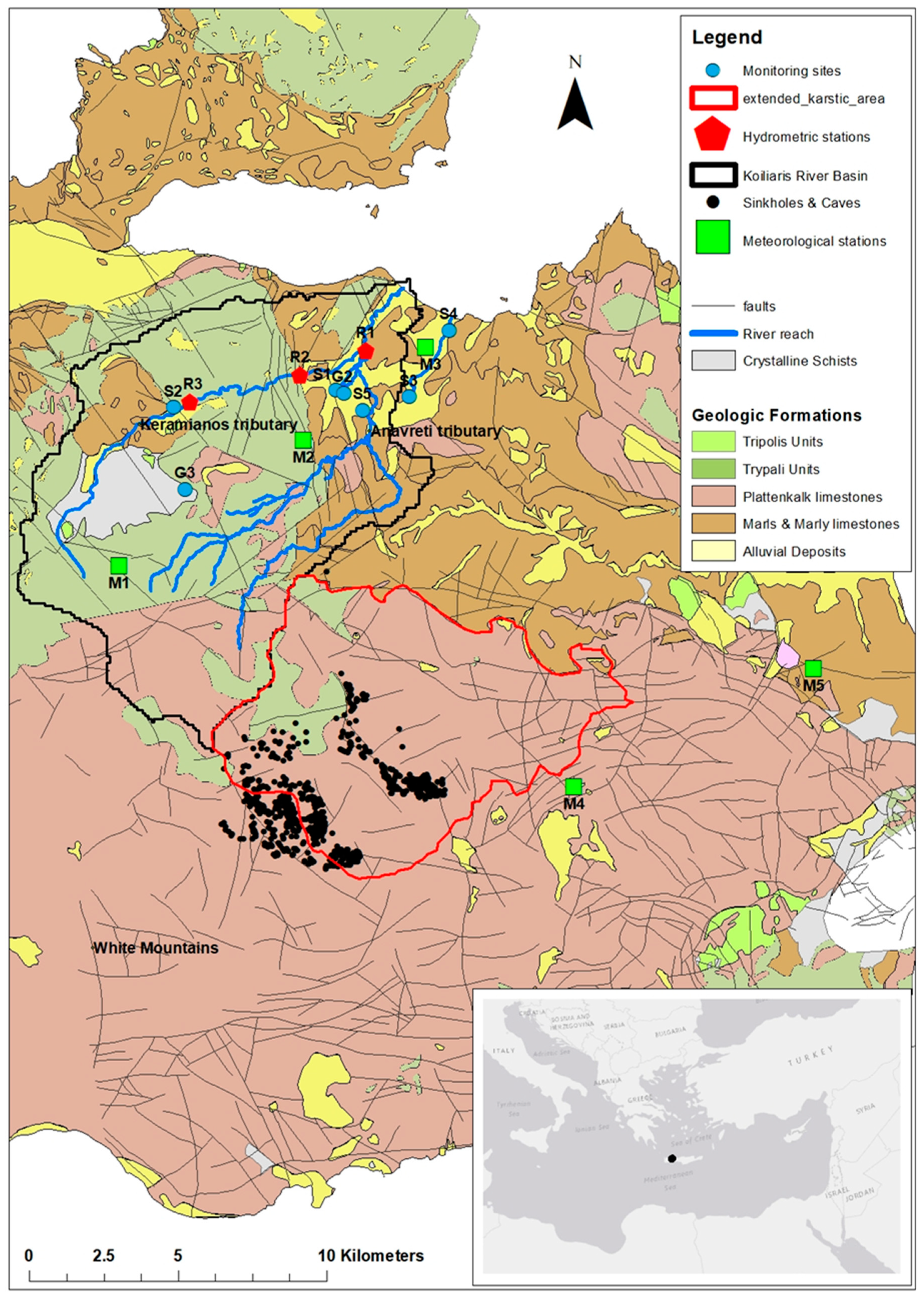
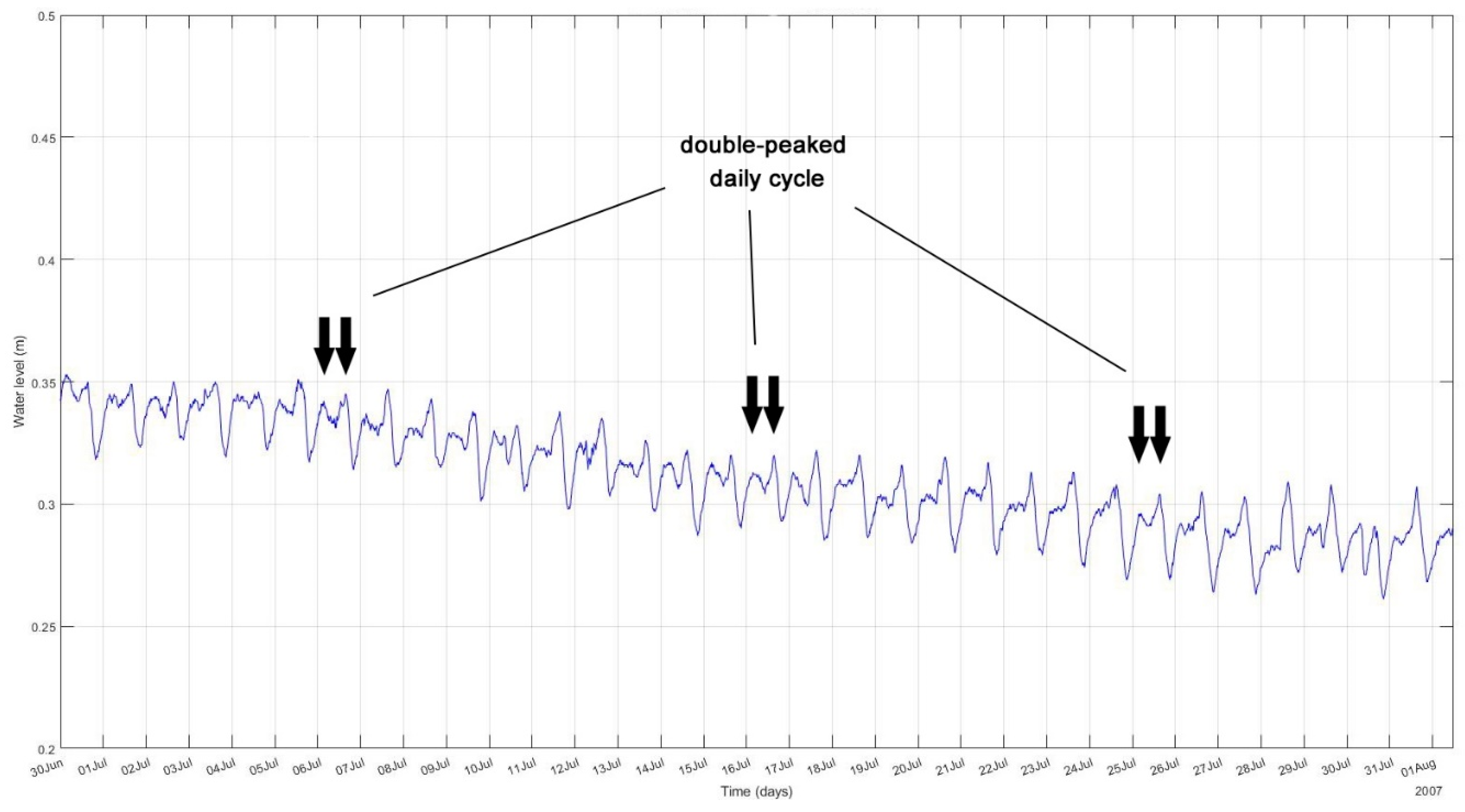

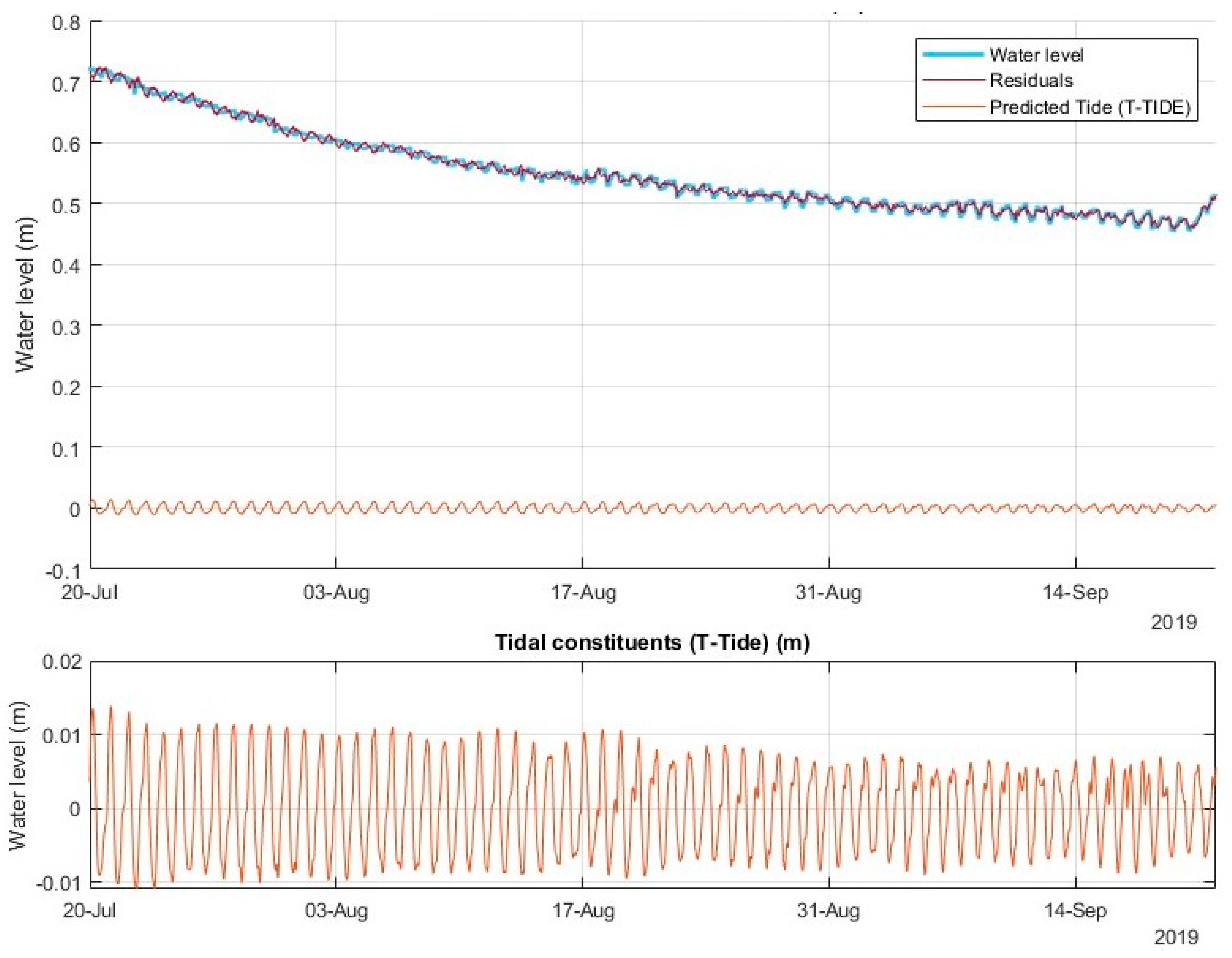
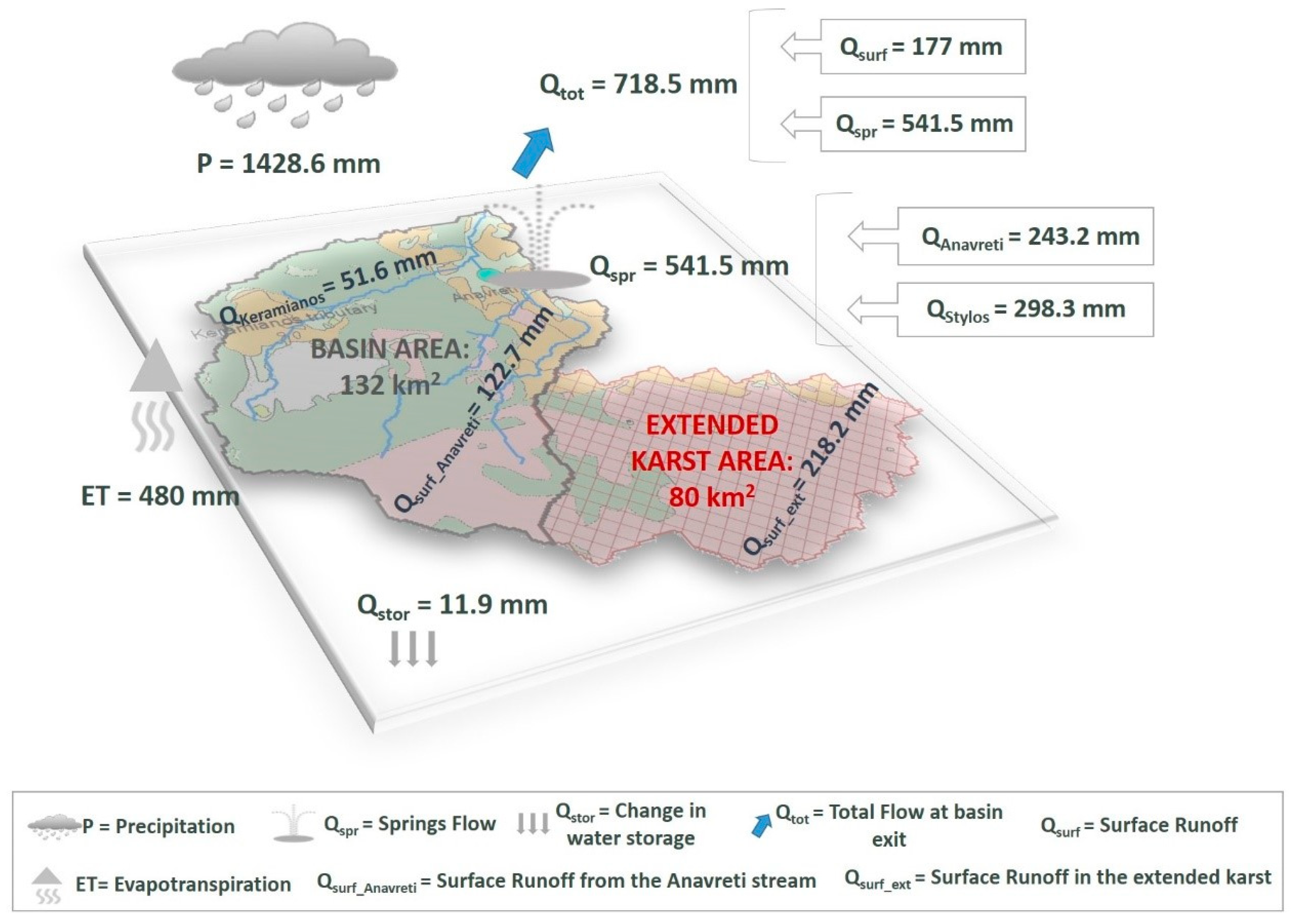
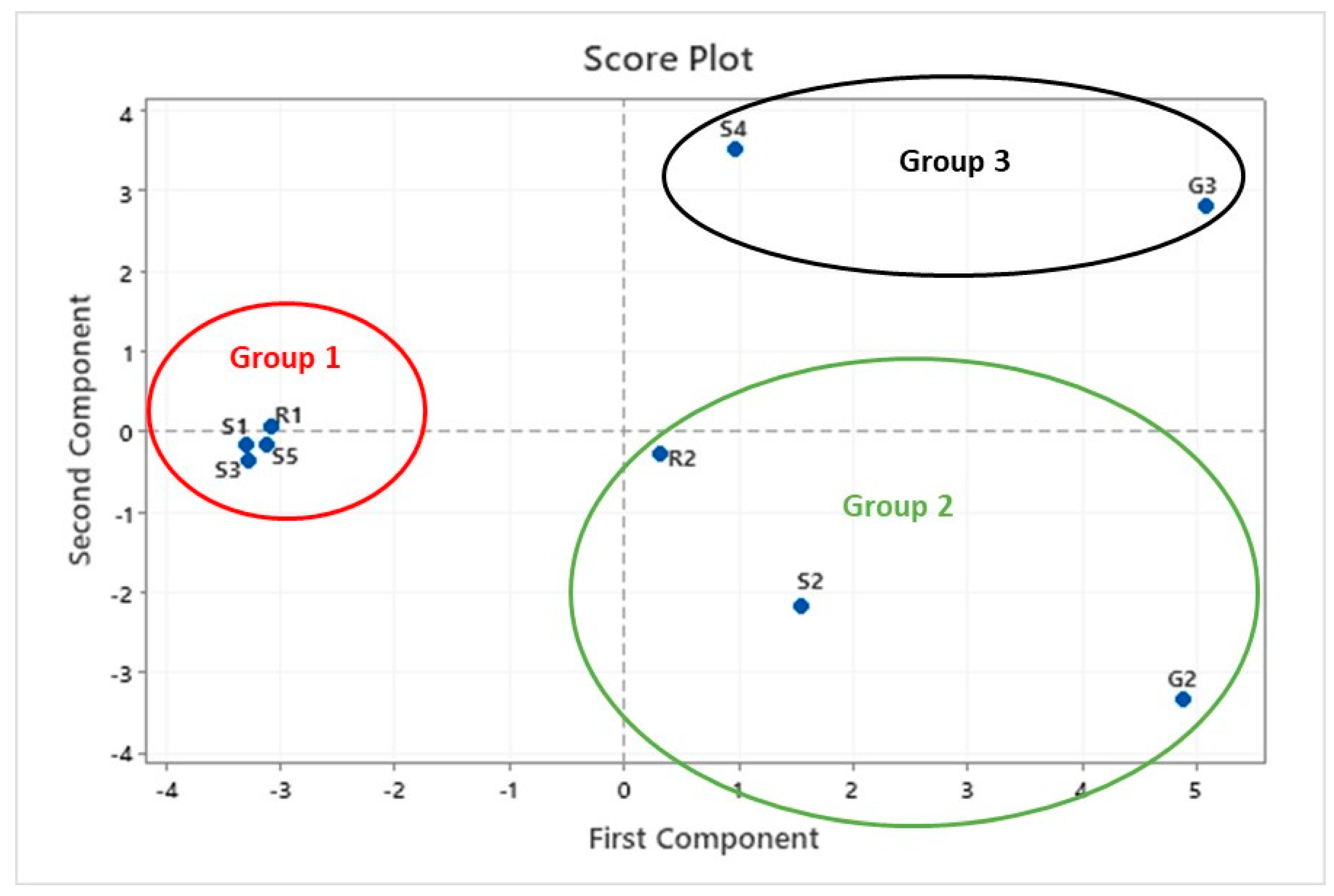
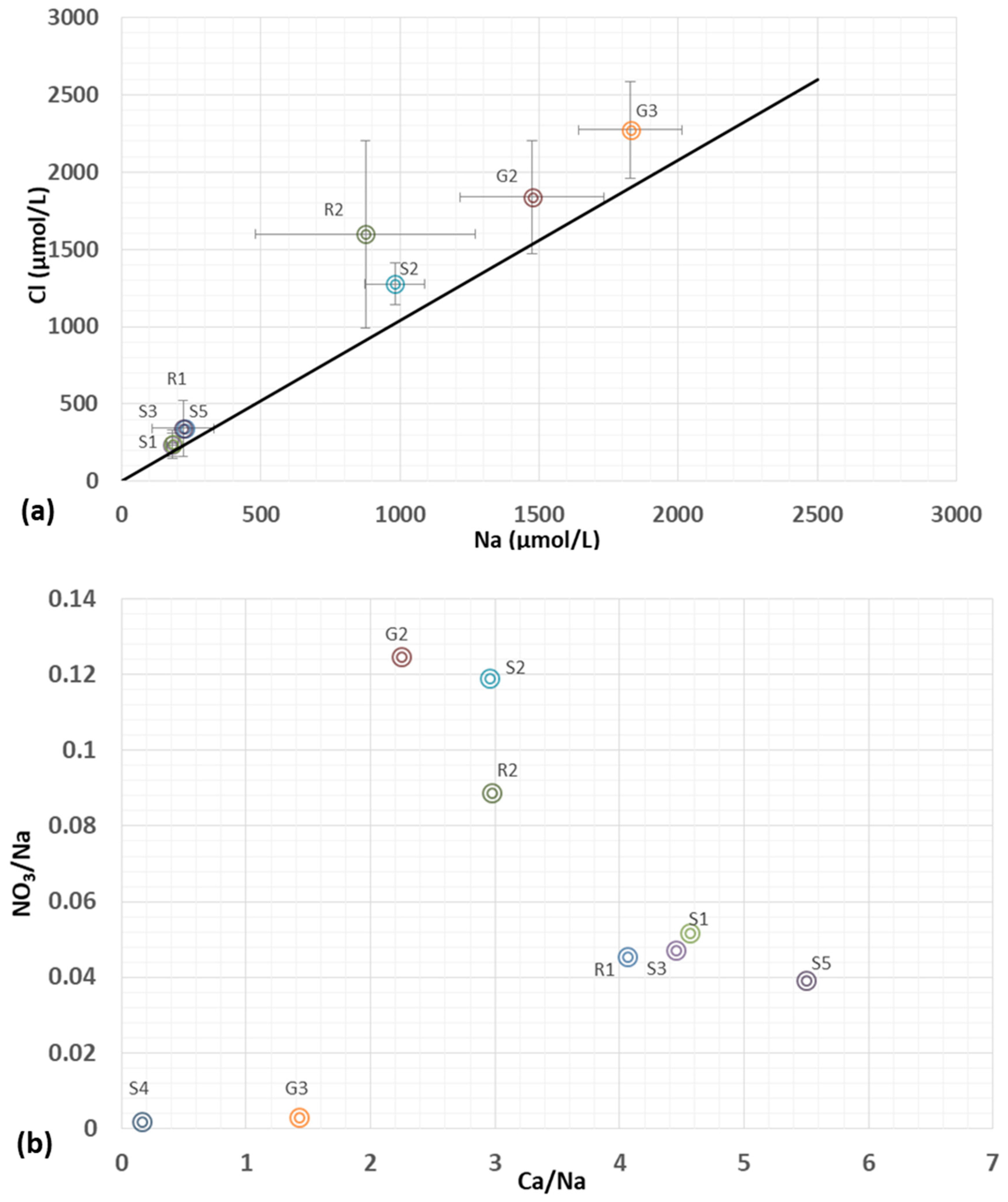

| 1. Stream and Ground Water Chemistry [16,17,18,19] |
|
| 2. Soil Degradation and Formation [11,20,21,22,23,24,25,26,27,28,29,30,31] |
|
| 3. Hydrologic and Geochemical Modeling of Complex Terrain [16,17,20,32,33,34,35,36,37,38] |
|
| 4. Sustainable Management of Water and Soil Resources [1,12,39,40,41,42,43,44,45,46,47] |
|
| 5. High Frequency Environmental Monitoring [15,48] |
|
| Period | Start Date | End Date | Duration (Days) | ER Number of Days | LR Number of Days |
|---|---|---|---|---|---|
| 2007 | 25 Mar 2007 | 14 October 2007 | 204 | ~79 | ~125 |
| 2013 | 22 July 2013 | 6 November 2013 | 108 | - | 108 |
| 2014 | 25 April 2014 | 26 September 2014 | 155 | ~49 | ~106 |
| 2017 | 13 June 2017 | 30 August 2017 | 79 | ~40 | ~39 |
| 2018 | 1 July 2018 | 11 September 2018 | 73 | ~48 | ~25 |
| 2019 | 20 July 2019 | 21 September 2019 | 64 | ~29 | ~33 |
| Tidal Component | Amplitude | Amplitude Error | Phase (°) | Phase Error (°) | Signal to Noise Ratio | Period (Days) |
|---|---|---|---|---|---|---|
| P1 | 0.0029 | 0.001 | 249.4 | 25.14 | 5.2 | 1.003 |
| K1 | 0.0087 | 0.001 | 242.33 | 8.48 | 47 | 0.997 |
| EPS2 | 0.0008 | 0 | 171.47 | 27.67 | 4 | 0.547 |
| L2 | 0.0006 | 0 | 27.96 | 42.38 | 2.2 | 0.508 |
| S2 | 0.0017 | 0 | 149.33 | 13.57 | 18 | 0.500 |
| MO3 | 0.0005 | 0 | 118.11 | 39.16 | 2.2 | 0.349 |
| SK3 | 0.0007 | 0 | 80.29 | 31.32 | 3.5 | 0.333 |
| SN4 | 0.0003 | 0 | 244.49 | 37.72 | 2.3 | 0.257 |
| MS4 | 0.0003 | 0 | 325.7 | 36.47 | 2.4 | 0.254 |
| S4 | 0.0005 | 0 | 73.69 | 22.46 | 6.5 | 0.250 |
| 2SK5 | 0.0003 | 0 | 307.9 | 28.33 | 4.2 | 0.200 |
| 3MK7 | 0.0002 | 0 | 98.22 | 37.23 | 2.3 | 0.147 |
| M8 | 0.0002 | 0 | 128.94 | 18.03 | 9.3 | 0.129 |
| R1 | S1 | S3 | S5 | S2 | G2 | R2 | S4 | G3 | |
|---|---|---|---|---|---|---|---|---|---|
| Number of Samples | 64 | 61 | 61 | 17 | 60 | 57 | 20 | 61 | 64 |
| Parameter | |||||||||
| pH | 8.1 | 8.0 | 8.0 | 8.0 | 7.0 | 7.3 | 7.8 | 7.8 | 7.6 |
| DO (mg/L) | 10.2 (0.9) | 11.0 (0.9) | 10.6 (1.4) | 10.7 (0.9) | 7.0 (1.5) | 2.3 (1.5) | 10.6 (1.6) | 10.1 (1.1) | 1.5 (1.3) |
| EC (μS/cm) | 240 (45) | 222 (36) | 222 (36) | 249 (85) | 718 (129) | 969 (122) | 658 (126) | 1133 (268) | 1029 (186) |
| N-NO3 (ppm) | 0.7 (0.6) | 0.6 (0.3) | 0.5 (0.2) | 0.5 (0.3) | 7.3 (2.4) | 10.4 (4.8) | 5.0 (3.3) | 0.8 (0.5) | 0.3 (0.4) |
| N-NH3 (ppm) | 0.05 (0.13) | 0.04 (0.07) | 0.02 (0.03) | 0.04 (0.03) | 0.04 (0.06) | 0.04 (0.05) | 0.07 (0.06) | 0.09 (0.10) | 0.10 (0.06) |
| P-PO4 (ppm) | 0.03 (0.05) | 0.03 (0.04) | 0.02(0.03) | 0.01 (0.01) | 0.05 (0.06) | 0.14 (0.11) | 0.05 (0.05) | 0.07 (0.22) | 0.06 (0.05) |
| Cl (ppm) | 12 (7) | 8 (5) | 8 (4) | 9 (6) | 45 (11) | 65 (19) | 56 (20) | 275 (87) | 78 (19) |
| SO4 (ppm) | 4 (3) | 3 (2) | 3 (2) | 5 (7) | 33 (14) | 62 (18) | 46 (16) | 47 (17) | 124 (23) |
| HCO3 (ppm) | 148 (49) | 144 (44) | 141 (46) | 146 (77) | 330 (140) | 386 (160) | 275 (125) | 193 (84) | 415 (145) |
| TOC (ppm) | 1.6 (1.3) | 1.3 (1.4) | 1.5 (1.7) | 1.4 (0.9) | 2.2 (1.9) | 2.9 (1.9) | 2.9 (2.2) | 1.5 (1.2) | 4.7 (2.4) |
| DN (ppm) | 0.6 (0.4) | 0.7 (0.4) | 0.7 (0.3) | 0.6 (0.4) | 8.7 (2.2) | 12.3 (4.1) | 5.0 (3.1) | 1.1 (0.9) | 0.5 (0.4) |
| Na (ppm) | 5 (2) | 4 (1) | 4 (1) | 5 (2) | 22 (3) | 34 (8) | 18 (9) | 177 (52) | 41 (7) |
| Mg (ppm) | 6 (2) | 5 (2) | 6 (2) | 4 (2) | 5 (1) | 9 (3) | 8 (2) | 23 (8) | 42 (9) |
| Si (ppm) | 0.9 (0.5) | 0.9 (0.5) | 0.9 (0.5) | 0.6 (0.6) | 3.6 (0.8) | 4.5 (1.4) | 2.6 (0.9) | 1.1 (0.5) | 5.1 (1.1) |
| K (ppm) | 0.4 (0.2) | 0.3 (0.2) | 0.3 (0.3) | 0.5 (0.5) | 1.3 (0.7) | 2.2 (1.9) | 2.1 (0.8) | 4.6 (2.1) | 5.1 (1.9) |
| Ca (ppm) | 36 (10) | 34 (8) | 33 (8) | 43 (13) | 119 (26) | 132 (35) | 86 (26) | 48 (12) | 104 (21) |
| Mn (ppb) | 1.3 (1.4) | 0.4 (1.4) | 0.1 (0.3) | 7.4 (7.6) | 0.3 (0.7) | 0.5 (0.8) | 1.8 (2.3) | 0.1 (0.3) | 76 (140) |
| Fe (ppb) | 6 (9) | 5 (7) | 3 (6) | 7 (10) | 8 (12) | 9 (14) | 14 (17) | 4 (14) | 9 (14) |
© 2020 by the authors. Licensee MDPI, Basel, Switzerland. This article is an open access article distributed under the terms and conditions of the Creative Commons Attribution (CC BY) license (http://creativecommons.org/licenses/by/4.0/).
Share and Cite
Lilli, M.A.; Efstathiou, D.; Moraetis, D.; Schuite, J.; Nerantzaki, S.D.; Nikolaidis, N.P. A Multi-Disciplinary Approach to Understand Hydrologic and Geochemical Processes at Koiliaris Critical Zone Observatory. Water 2020, 12, 2474. https://doi.org/10.3390/w12092474
Lilli MA, Efstathiou D, Moraetis D, Schuite J, Nerantzaki SD, Nikolaidis NP. A Multi-Disciplinary Approach to Understand Hydrologic and Geochemical Processes at Koiliaris Critical Zone Observatory. Water. 2020; 12(9):2474. https://doi.org/10.3390/w12092474
Chicago/Turabian StyleLilli, Maria A., Dionissis Efstathiou, Daniel Moraetis, Jonathan Schuite, Sofia D. Nerantzaki, and Nikolaos P. Nikolaidis. 2020. "A Multi-Disciplinary Approach to Understand Hydrologic and Geochemical Processes at Koiliaris Critical Zone Observatory" Water 12, no. 9: 2474. https://doi.org/10.3390/w12092474
APA StyleLilli, M. A., Efstathiou, D., Moraetis, D., Schuite, J., Nerantzaki, S. D., & Nikolaidis, N. P. (2020). A Multi-Disciplinary Approach to Understand Hydrologic and Geochemical Processes at Koiliaris Critical Zone Observatory. Water, 12(9), 2474. https://doi.org/10.3390/w12092474






